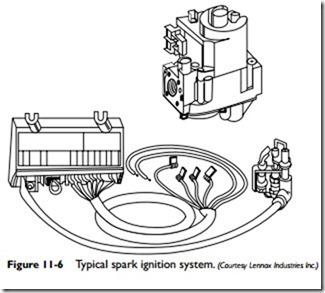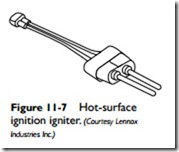High-Efficiency Gas Furnaces
High-efficiency gas furnaces (also sometimes called condensing furnaces or electronic ignition furnaces) have AFUE ratings of 90 percent or more (Figure 11-5). The ignition process in these furnaces is controlled by a solid-state circuit board. There is no continuously burning pilot flame.
High-efficiency furnaces are equipped with two and sometimes three heat exchangers to extract the maximum amount of heat from the flue gases. The condensate resulting from the heat extraction process is then passed out of the bottom of the furnace to a nearby drain. The flue gas temperatures are low enough for the remaining gases to vent outdoors through a narrow PVC pipe.
There is no need to vent the gases up a chimney. There are two types of high-efficiency furnace: the intermittent-pilot furnace and the hot-surface ignition (HSI) furnace.
Intermittent-Pilot Furnace
An intermittent-pilot furnace (also sometimes called a spark ignition furnace) has many of the same components as a conventional standing-pilot type, including a pilot light assembly, except for a more efficient heat exchanger and an electronic ignition system. When the thermostat setting calls for heat, there begins a short ignition trial period during which a high-voltage spark is generated. The spark ignites the pilot. If the attempt to light the pilot was successful, the pilot flame must be proven through the flame rectification process. If the flame is proven, the solid-state circuit board in the furnace control box sends a signal to the main gas valve, opening it to permit gas to flow to the burner (Figure 11-6). The pilot flame then lights the gas burner, which continues to burn until the heat has reached the desired level inside the structure, whereupon the thermostat signals the electronic module or circuit board to stop the ignition process and shut off the pilot and burner.
Some intermittent-pilot furnaces use a pilot relight module and a mercury flame sensor instead of a control module to operate the pilot and gas valve. The gas valve is identical to the one used in furnaces with solid-state control modules. These furnaces are some- times called cycle pilot furnaces.
Hot-Surface Ignition (HSI) Furnace
The hot-surface ignition (HSI) furnace is an electronically controlled furnace with two or more heat exchangers. An electronic ignition device called a hot surface igniter (also sometimes called a glow stick or glow plug) is used instead of a pilot light to start the gas burner (Figure 11-7). The tip of the igniter is positioned directly above the gas burner opening. When the thermostat setting calls for heat, the furnace begins a sequence of pre-ignition steps including a purge cycle. After the purge cycle, an electric current is sent to the igniter and heats the surface of the element until it reaches a high enough temperature to ignite the burner. At that point, the main gas valve is opened and gas flows to the burner and is ignited. A flame-sensing rod connected to a solid-state control module is used to detect (prove) the gas flame at the burner nozzle through flame rectification. If the flame can be proven, the electrical current to the igniter is shut off. In these furnaces, the solid-state ignition unit provides direct ignition and burner control.
Note
Some of these furnaces ignite the gas with a high-voltage direct spark instead of a red-hot igniter element. These furnaces are sometimes called direct-spark furnaces. All the other components are the same as those used in a conventional HSI furnace.


